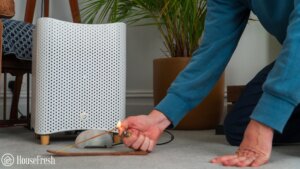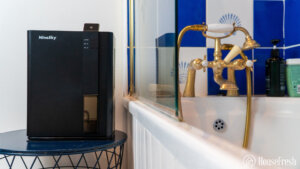Since Colorado and Washington passed legislation for recreational cannabis use in 2012, many more states have followed suit, opening the door for people nationwide to enjoy smoking weed in their homes.
Whether you use marijuana for health, to relax, or to socialize, it can’t be denied that the smell lingers and is a real downside to enjoying cannabis in the home. Smoking cannabis is only permitted for use inside private property, resulting in odors sticking to clothes, hair and furniture and will be noticeable to visitors to your home.
As well as leaving a lingering odor, smoking cannabis indoors has been found to dramatically increase the level of PM2.5 particulate matter, including carcinogens and toxic chemicals, which can result in serious health effects for smokers and second-hand smokers alike. Some tests found that air quality levels worsened 100-fold, even when no tobacco was used.
Thankfully, getting a high-powered air purifier can allow you to remove these particles and gasses generated from weed smoke using an air purifier fitted with a HEPA and activated charcoal filter.
Since 2021, we have tested and reviewed 54 different popular air purifiers, so we have the data to identify what we think are the best weed smoke air purifiers in 2024.
- In our home lab of 728 cubic feet, we light an incense stick to generate particle pollution and VOCs.
- We set up our trusted Purpleair Indoor Sensor with the latest Bosch gas sensor to track levels of PM1ug/m3, PM2.5ug/m3 and PM10ug/m3 and VOCs in the air.

- We switch the air purifier to its highest speed and measure how long it takes to get our room air quality down to PM1 level to 0.
- We use an energy meter to measure precisely how much electricity is used when running the unit at the lowest and highest fan speed settings.
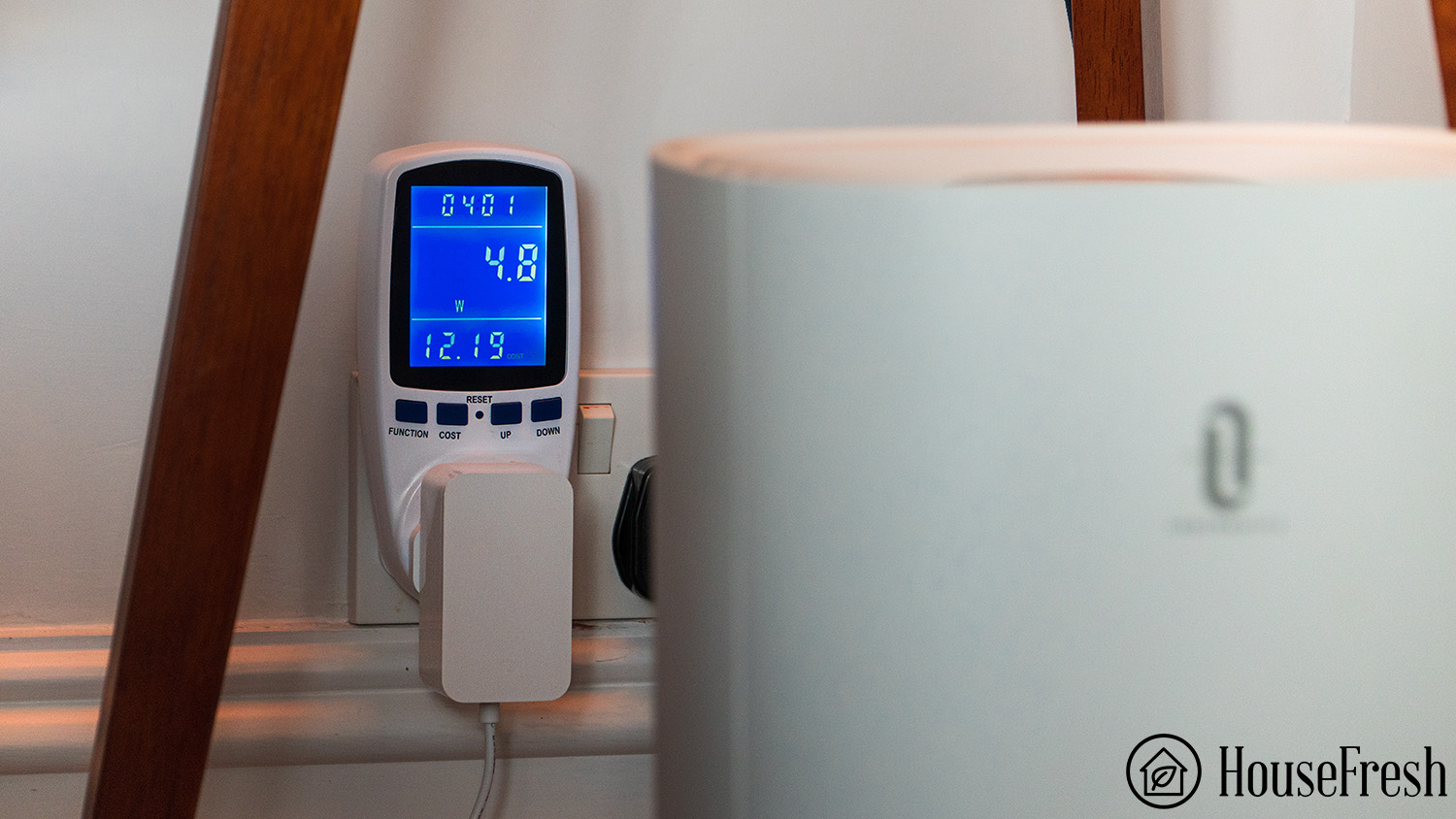
- We track sound levels emitted by the air purifier at different fan speeds with the help of a commercial sound meter.

Burning cannabis produces a vast number of particles and gasses that need to be removed, so we selected the best-performing devices from our in-house testing as well as those that didn’t create excessive noise, but many don’t come cheap.
In reality, weed smoke is one of the trickiest pollutants to deal with, so you need to use large devices with large filters and powerful air cleaning power.
- HEPA will remove the particles related to weed smoke, but you need a lot of activated charcoal to deal with odors. For those with major concerns with odors, such as heavy-smoking neighbors, you will want to look at the IQAir Healthpro Plus or Austin Air Healthmate, as both have very large carbon filters.
1. Staff pick: IQAir Healthpro Plus
IQAir is the oldest air purification company, and the IQAir Healthpro Plus has all you need to deal with both particles and odors from weed smoke.

The IQAir Healthpro Plus has a large HyperHEPA filter and 5 lbs of activated charcoal with zeolite for dealing with weed smoke odors.
It’s not going to win any design awards. Still, it’s the best air purifier on the market that is effective at removing particles (25 minutes to bring PM1 to zero in our test) and uses one of the largest activated carbon filters on the market.
What we really like
What we think could be better
While this air purifier might not be affordable for everyone, its performance in dealing with both gasses and odors is why it is our top choice for dealing with weed smoke in 2024.
In our in-house performance test, it managed to bring the level of PM1 down to zero in 25 minutes, which is impressive considering it’s also pushing the air through one of the largest activated charcoal filters on the market.
The air purifier industry is full of many fly-by-night brands, but IQAir has been here since 1963 and is one of the most trusted names in the industry.
If you are serious about dealing with odors and particles from weed smoke, the IQAir Healthpro Plus is worth the investment.
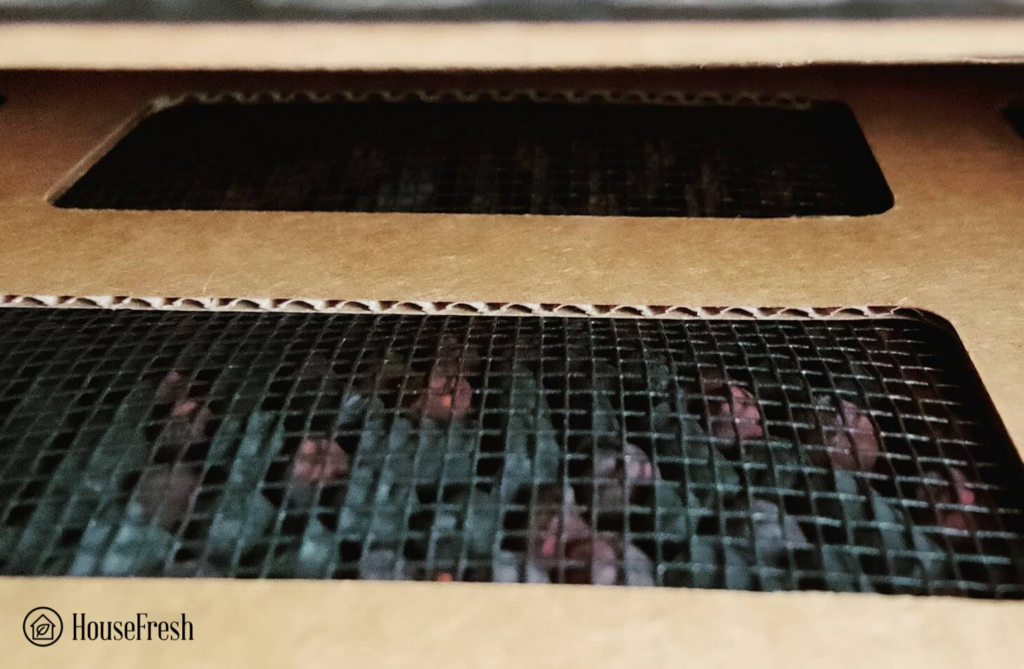
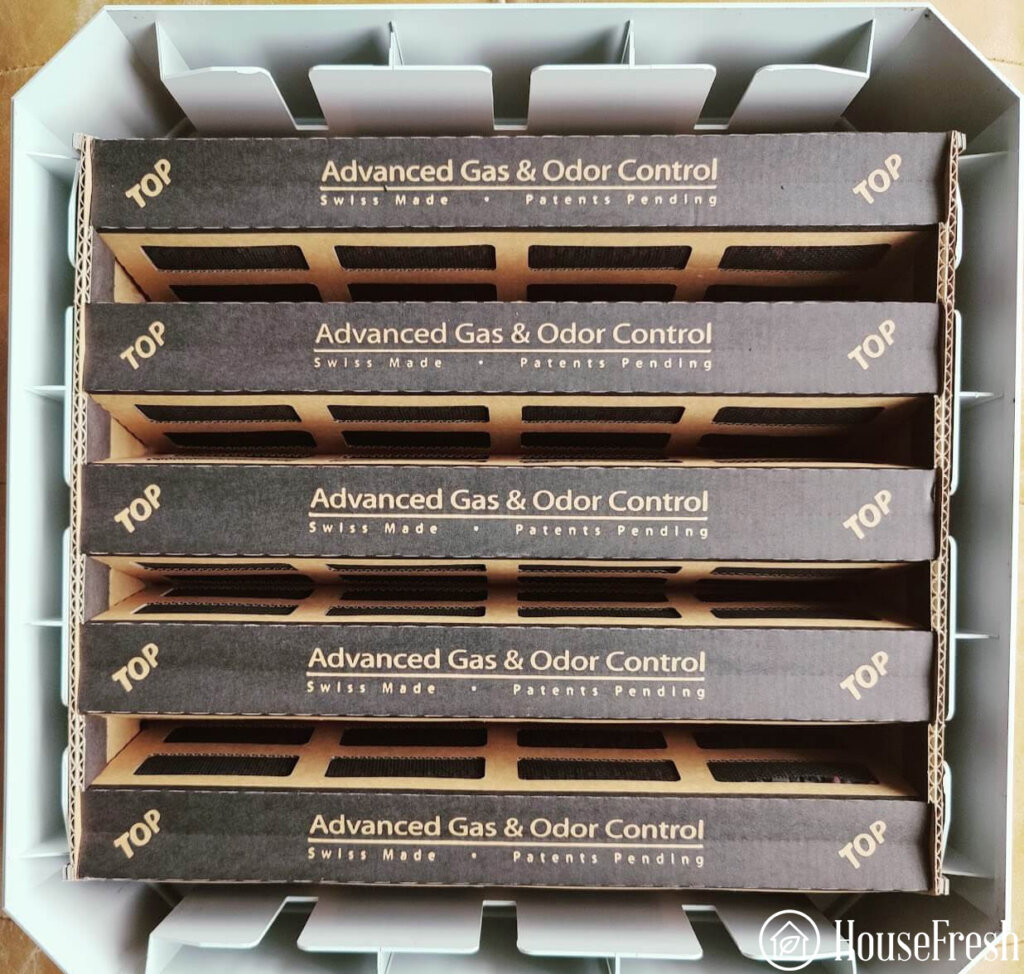
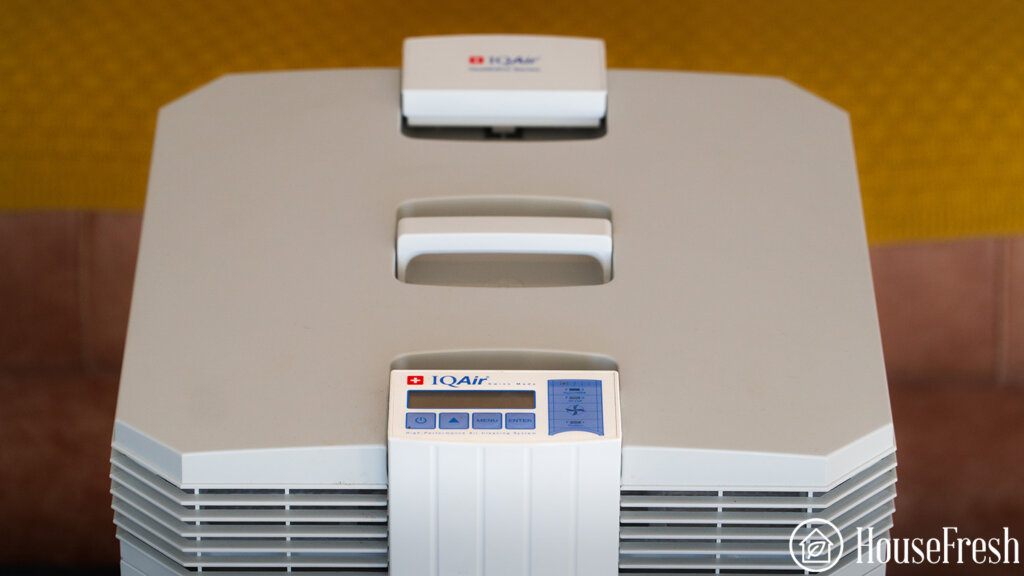
SPECS & FEATURES
| HouseFresh Rating: | ★★★★★ |
| Time to clean our test room: | PurpleAir Touch: 24 minutes PurpleAir Zen: 28 minutes |
| Air purifier technology: | HyperHEPA and V50-CELL gas and odor filter |
| Recommended room size: | 450 to 1,125 sq. ft. |
| Clean air delivery rate (CADR): | 300 CFM (510 m³/h) |
| Dimensions (in inches / in cm): | 28H x 18W x 16D inches (71H x 38W x 41D cm) |
| Weight (in pounds / in kg): | 35 lbs (16 kg) |
| Noise level (measured from 3 ft. away): | Speed 1: 36.9 dB Speed 2: 40.9 dB Speed 3: 47.2 dB Speed 4: 53.9 dB Speed 5: 61.2 dB Speed 6: 69 dB |
| Filter life: | 4 years |
| Electricity consumption (kilowatt-hour): | Standby mode: 1 kWh Speed 1: 16.5 kWh Speed 2: 32.7 kWh Speed 3: 47.3 kWh Speed 4: 69 kWh Speed 5: 94.3 kWh Speed 6: 145.2 kWh |
| Estimated running costs (electricity consumption + filter replacements): | $437.34 per year |
| Manufacturer’s warranty: | 10 years |
| Country of manufacture: | Switzerland / Germany |
2. Best for intense weed odors: Austin Air Healthmate
The largest carbon-sized carbon filter on the market with over 15lbs of activated charcoal

With 15 lbs. of activated carbon included in the Austin Air Healthmate as standard, you’ll struggle to find another air purifier better equipped to deal with the harmful VOCs and odors associated with weed smoke.
As this filter is so big, it offers protection in spaces with heavy plumes of smoke. In addition to this, the filter will last for an epic five years, so you don’t need to worry about replacing it too often.
What we really like
What we think could be better
As well as a colossal carbon filter, you’ll find a True HEPA and two separate pre-filters to tackle weed smoke’s particulate matter and other household pollutants. Plus, this unit is straightforward to use; plug it in and cycle through its one-dial control panel to find the right fan speed for your needs.
It doesn’t quite make our top spot as its particle removal performance was much worse than the IQAir Healthpro Plus, but for those who want to primarily deal with a serious odor issue from weed smoke – the Austin Air Healthmate won’t disappoint.


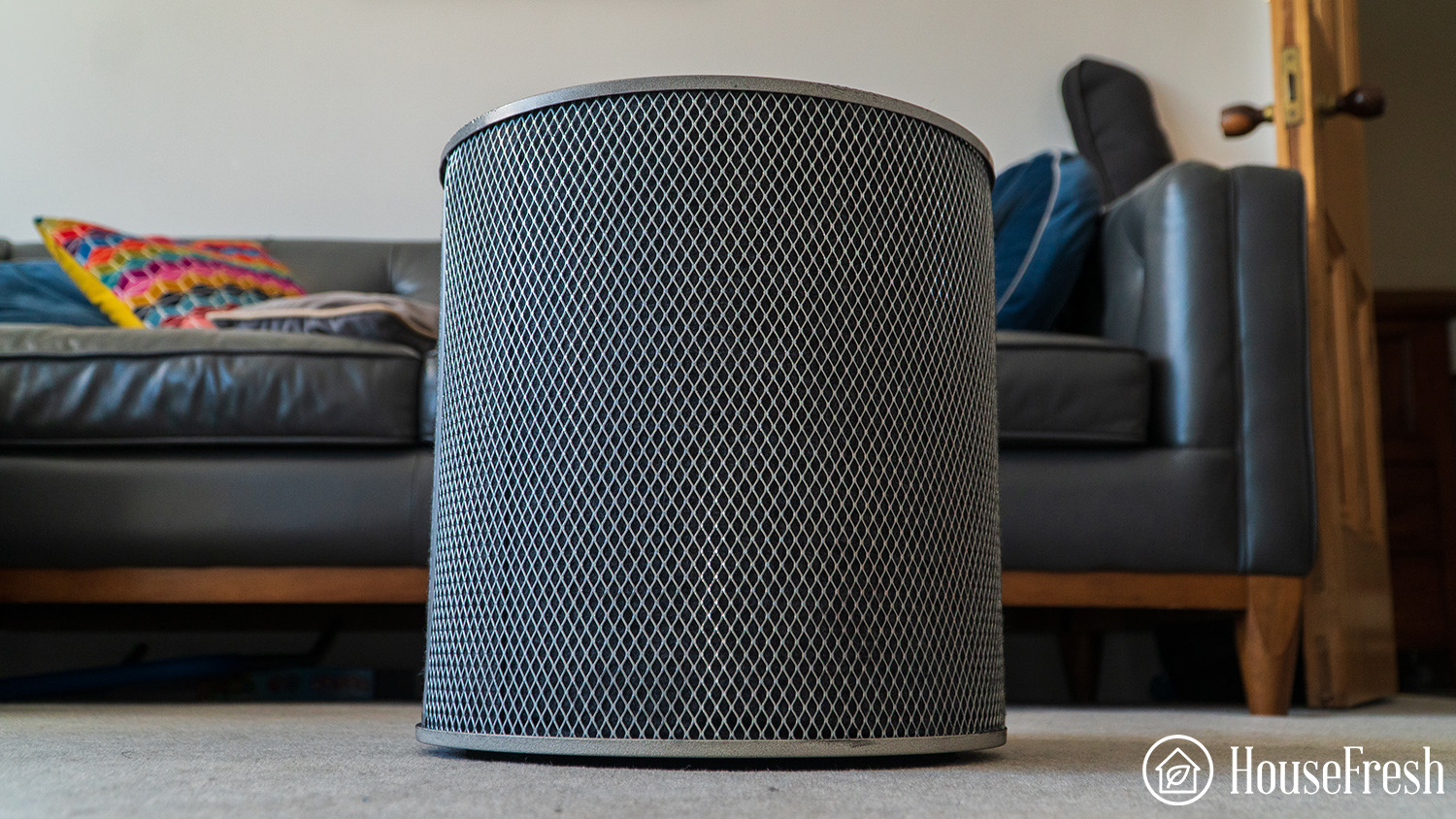
SPECS & FEATURES
| HouseFresh Rating: | ★★★★☆ |
| Time to clean our test room: | 36 minutes |
| Air purifier technology: | Carbon Filter, HEPA Filter, Pre-Filter, Large Particle Pre-Filter |
| Recommended room size: | 750 to 1500 sq. ft. |
| Clean air delivery rate (CADR): | 150 CFM (estimated based on HouseFresh tests) |
| Dimensions (in inches / in cm): | 23H x 14.5W x 14.5D inches (58.4H x 36.8W x 36.8D cm) |
| Weight (in pounds / in kg): | 47 lbs (21.3 kg) |
| Noise level (measured from 3 ft. away): | Speed 1: 42 dB Speed 2: 53.2 dB Speed 3: 61.5 dB |
| Filter life: | 5 years |
| Electricity consumption (kilowatt-hour): | Standby mode: 0 kWh Speed 1: 61.1 kWh Speed 2: 85.05 kWh Speed 3: 147.6 kWh |
| Estimated running costs (electricity consumption + filter replacements): | $254.56 per year |
| Manufacturer’s warranty: | 5 years |
| Country of manufacture: | US – Buffalo, New York |
3. Best smart unit: Levoit EverestAir
The Levoit EverestAir is a high-performing smart air purifier that is powerful enough to deal with weed smoke
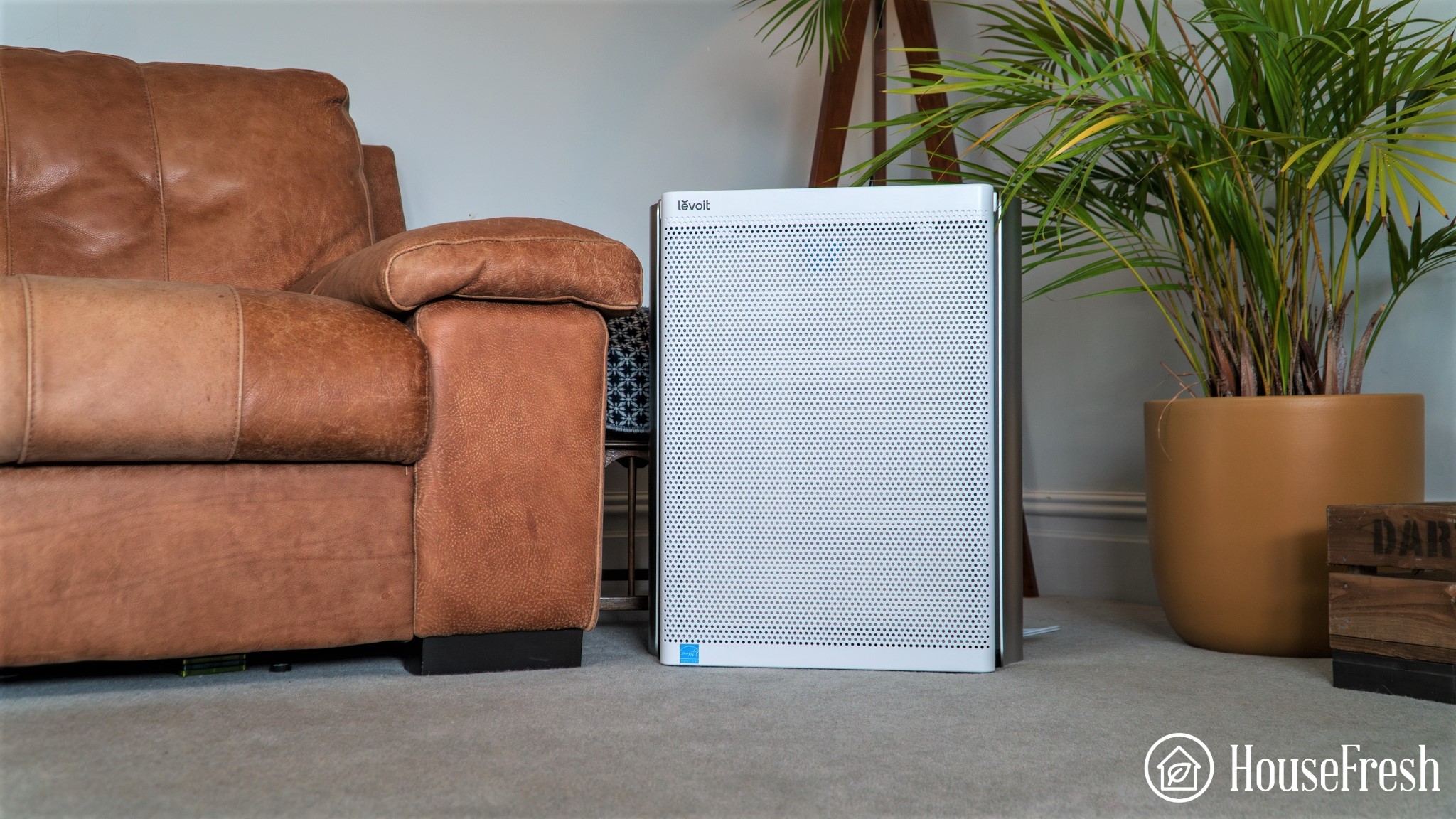
The EverestAir works fast, preventing smoke and odors from permeating the air and sticking to your clothes and furniture. During our speed test, this air purifier took only 13 minutes to clean the air of all pollutants — making it the fastest unit we have ever tested.
This speedy purifier is powered by fans that are capable of circulating the air in spaces as big as 2790 sq. ft. This makes it a top choice for large open-plan homes or those looking to achieve quick-fire air changes in smaller spaces to prevent smoke from spreading.
Thanks to its highly efficient primary filter and an activated carbon filter with ARC Formula™, the EverestAir can remove particulate matter and VOC pollutants in weed smoke. We saw that even the smallest PM1 particles were quickly removed by the EverestAir, although with only 0.88 lbs of activated charcoal, it won’t be as effective as our choices above for odors from weed.
What we really like
What we think could be better
Unlike our top two choices, the EverestAir comes with a ton of bells and whistles, from a rapid auto-mode that will kick in within seconds of detecting weed smoke to full app support that will allow you to see the air quality via your smartphone. With the VeSync app, you can control the purifier remotely. This allows you to tweak settings, get filter life reminders, create schedules, set timers and adjust the vent angles, all from your phone.
Something worth mentioning is that the EverestAir cleared the air from smoke in our home lab fast, both when running at its top fan speed (13 minutes) and even when it was at the lowest speed; it still took only 25 minutes to bring the level of PM1 to zero at only 24 dBA – which was close to silent to my ears.
Although whenever smoking indoors, you’ll want to run the purifier at its top speed setting, it’s great to know that the EverestAir’s air cleaning performance is still excellent at its lowest speed, too. This means you can achieve protection from weed smoke odors around the clock while benefiting from lower energy use and near-silent operating volumes.


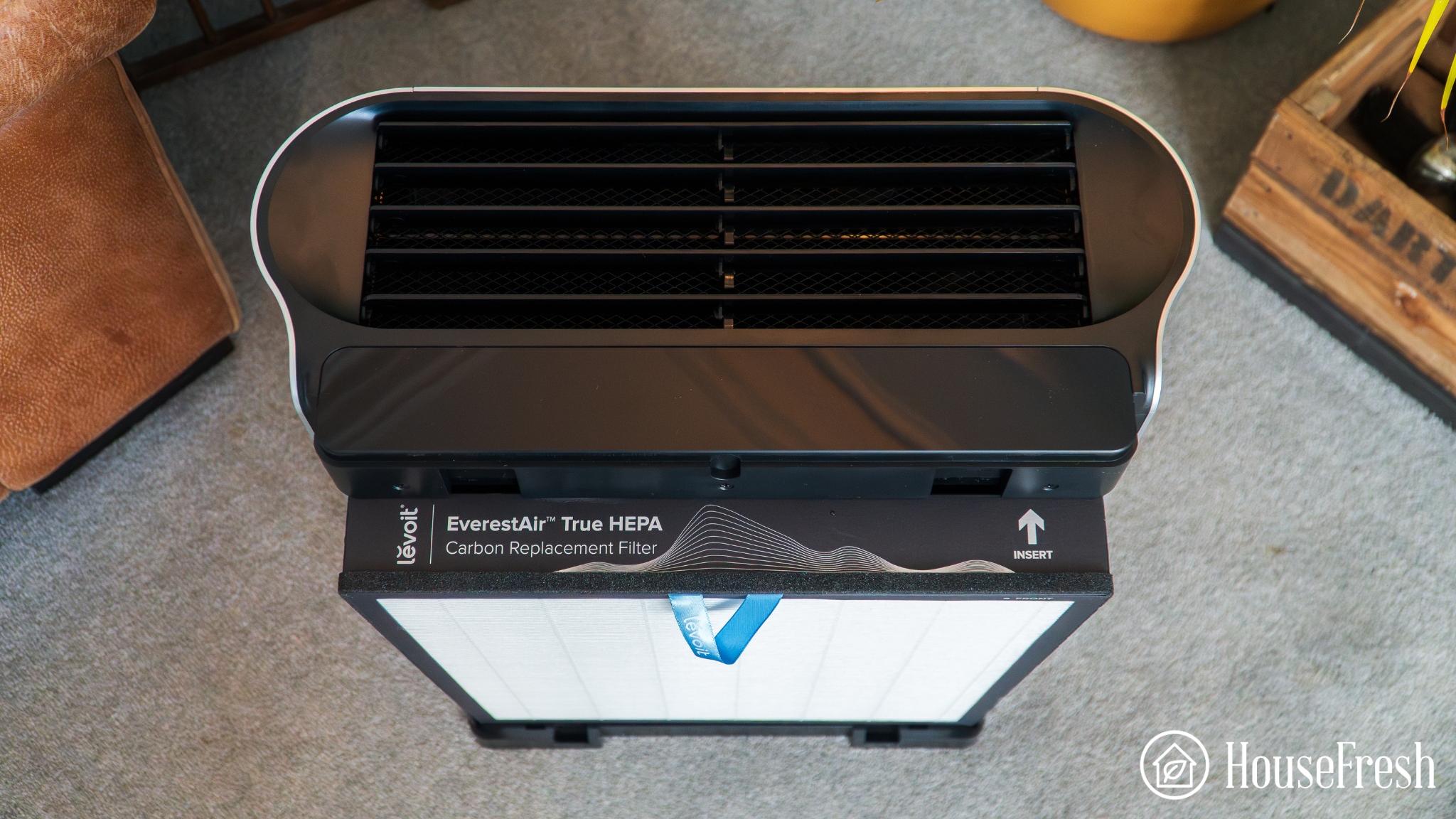
SPECS & FEATURES
| HouseFresh Rating: | ★★★★★ |
| Time to clean our test room: | 13 minutes |
| Air purifier technology: | 3-Stage Filtration (Pre-filter for large particles, main filter for airborne particles, high-efficiency activated carbon filter for odors and gasses) |
| Recommended room size: | 558 sq. ft. |
| Clean air delivery rate (CADR): | 360 CFM (612 m3/h) |
| Dimensions (in inches / in cm): | 18.9L x 8.5W x 23.2H inches (48L x 21.6W x 58.9H cm) |
| Weight (in pounds / in kg): | 20.7 lbs (9.38 kg) |
| Noise level (low – high): | 24 – 56dB |
| Filter life: | 12-15 months |
| Warranty: | 2 years |
| Estimated energy consumption: | $87.25 per year |
| Country of manufacture: | China |
4. Best with on/off ionizer function: Winix 5500-2
The Winix 5500-2 is an air-cleaning powerhouse from a trusted manufacturer.

The Winix 5500-2 comes with high-quality filters and large fans to easily circulate air and remove even the smallest particles . The air filtration of the 5500-2 is supercharged by combining a granular activated carbon filter (which nips weed odors in the bud) and a HEPA-certified primary filter.
Another feature of the 5500-2 that guarantees outstanding air cleaning is its ionizer function, which can help improve performance compared to HEPA alone. The good news is that you can turn the ionizer off if you’re concerned about potentially dangerous byproducts, such as ozone.
What we really like
What we think could be better
Considering that this air purifier can often be bought for less than $160, I was shocked to see how fast it performed in our air cleaning speed test, taking just 18 minutes to remove all traces of pollutants from the testing lab.
The 5500-2 is faster at cleaning the air than air purifiers, which cost twice its price. An example is the $900 IQAir HealthPro Plus, which took 25 minutes to clear the same space.



SPECS & FEATURES
| HouseFresh Rating: | ★★★★☆ |
| Time to clean our test room: | – 18 minutes with PlasmaWave ionizer – 22 minutes without PlasmaWave enabled |
| Air purifier technology: | PlasmaWave, removable pre-filter, washable activated carbon filter and True HEPA filter |
| Recommended room size: | 360 sq. ft. (4.8 ACH) |
| Clean air delivery rate (CADR): | – Smoke: 232 CFM – Dust: 243 CFM – Pollen: 246 CFM |
| Dimensions (in inches / cm): | 15W x 8.2D x 23.6H inches (38W x 21D x 60H cm) |
| Weight (in pounds / in kg): | 14.8 lbs (6.7kg) |
| Noise level (measured from 3 ft. away): | Speed 1: 38.8 dB Speed 2: 42.5 dB Speed 3: 47.5 dB Speed 4: 58.9 dB |
| Filter life: | 12 months |
| Electricity consumption (kilowatt-hour): | Standby mode: 0.34 kWh Speed 1: 6.5 (7.1) kWh Speed 2: 9.11 (9.2) kWh Speed 3: 14.80 (15) kWh Speed 4: 53.46 (53.8) kWh |
| Estimated running costs (electricity consumption + filter replacements): | $135.70 per year |
| Manufacturer’s warranty: | 2 year |
| Country of manufacture: | South Korea |
5. Best warranty: Alen BreatheSmart 45i
The 45i offers excellent air cleaning performance thanks to its high-grade air filters.

Combining stellar performance with some of the best filters on the market, the BreatheSmart 45i ticks all the boxes of a weed-smoke busting air purifier. You’ll find a medical-grade H13 HEPA filter that removes 99.95% particulates as small as 0.1 microns . Alen also provides the user a choice of carbon filter, with large amounts of charcoal substrate to lock in odors and harmful chemicals that are prevalent in smoke-filled air.
What we really like
What we think could be better
When combatting weed smoke, you’ll want an air purifier that is ultra-reliable. And that’s exactly what you’ll get from Alen. Their air purifiers offer a brilliant build quality that is backed up by a lifetime warranty – the only air purifier brand I’ve seen offer this guarantee.
In addition to all the pros I’ve already covered, this device is sleek and looks really good. It is easy to move from room to room as it’s not too heavy and comes with a handle at the back. Want even more pros? The 45i comes with an auto mode, meaning you can turn it on and leave it to do its job.
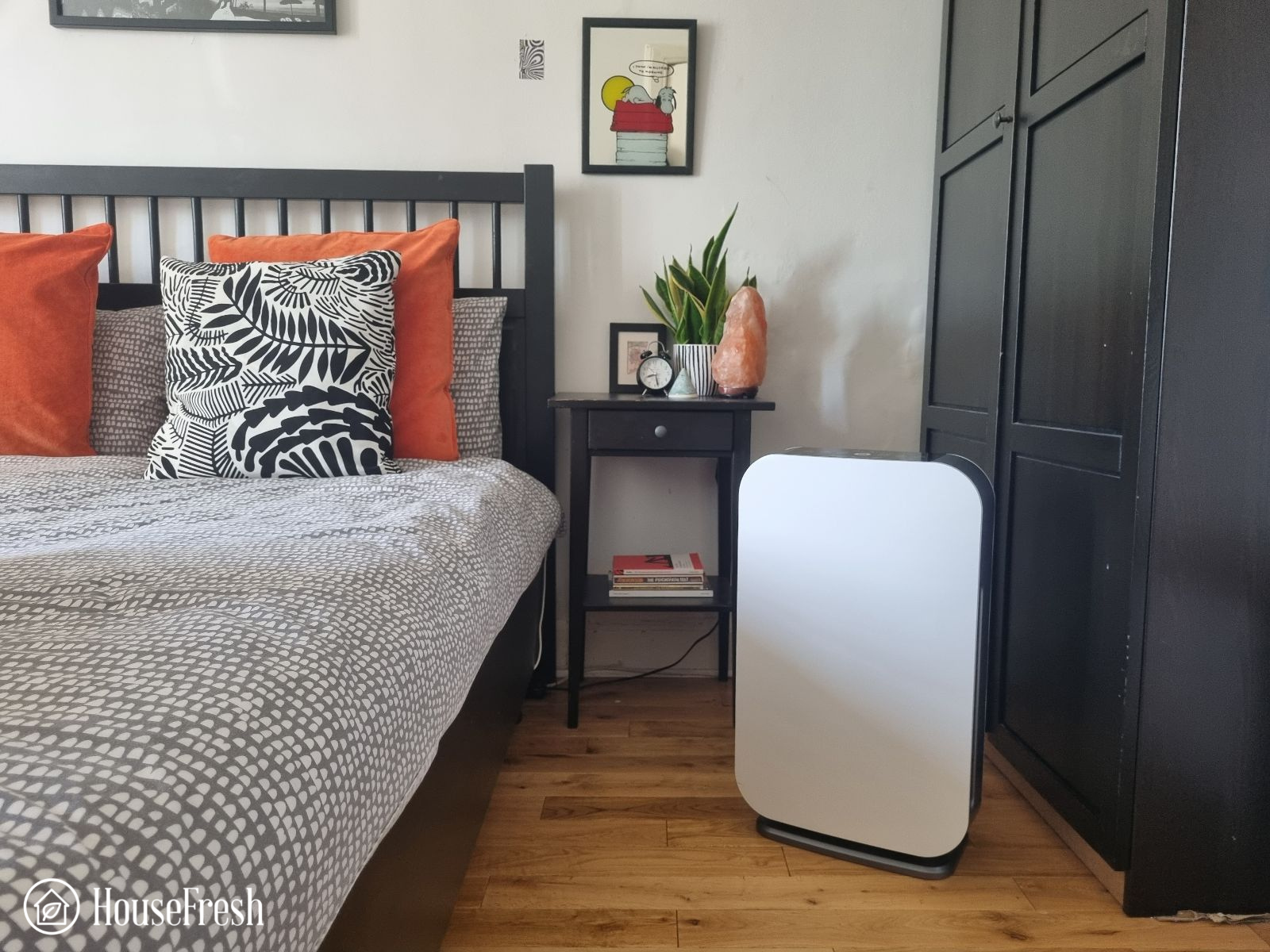
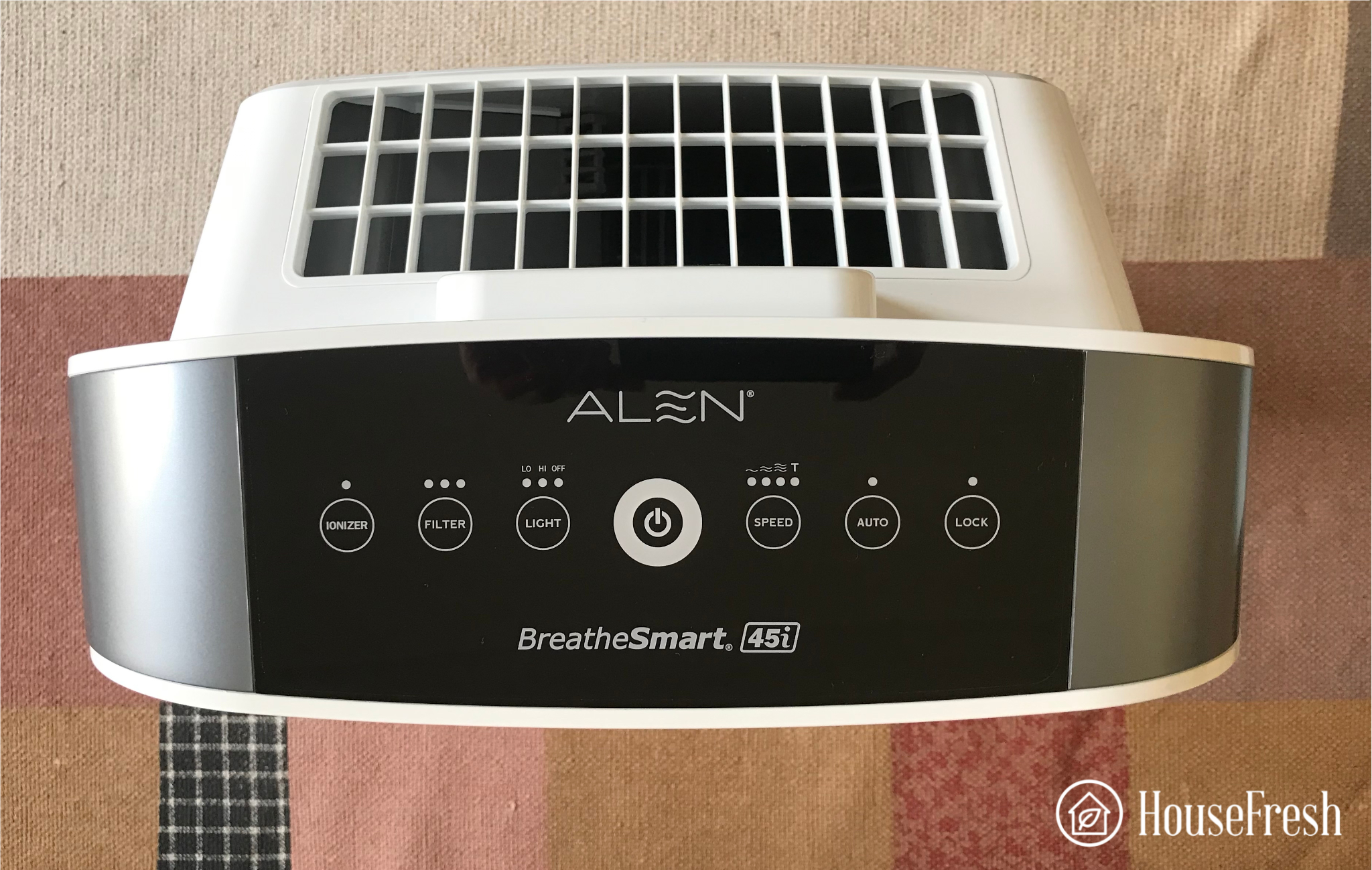
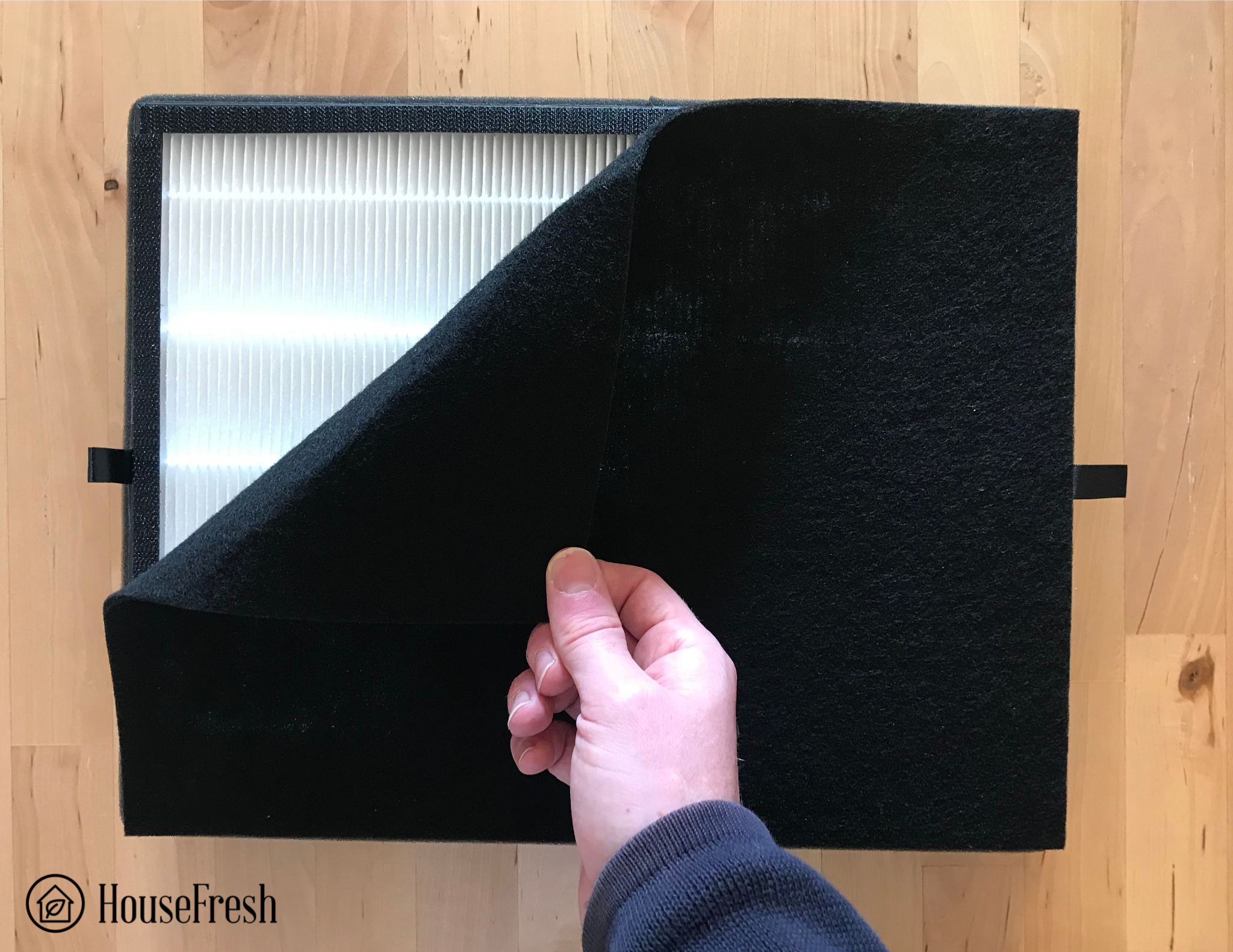
SPECS & FEATURES
| HouseFresh rating: | ★★★★☆ |
| Time to clean our 728 cubic feet test room (with the device running at top speed): | 33 minutes |
| Air purifier technology: | True HEPA H13 filters with activated carbon pellets + Ionizer technology |
| Recommended room size (4.8 air changes per hour): | Up to 800 sq. ft. |
| Clean air delivery rate (CADR): | Dust: 208 CFM Smoke: 194 CFM Pollen: 230 CFM |
| Dimensions (in inches / in cm): | 25H x 15W x 8.5D inches (63.5H x 38.1W x 21.6D cm) |
| Weight (in pounds / in kg): | 20.1 lbs (9.1 kg) |
| Filter life: | 12 months |
| Noise level in decibels (measured from 3 ft. away with a sound level meter): | Speed 1: 36.2 dB Speed 2: 45.7 dB Speed 3: 51.1 dB |
| Electricity consumption in watts (recorded with an electricity usage monitor): | Standby mode: 0.8 watts Speed 1: 4.4 watts Speed 2: 7.4 watts Speed 3: 15.2 watts Speed 4: 25.3 watts |
| Estimated running costs (electricity consumption + official filter replacements): | $105.40 per year |
| Cost per CADR cfm (based on dust CFM as reported by AHAM): | $2.06 |
| Manufacturer’s warranty: | Lifetime (with product registration & active filter subscription) |
| Country of manufacture: | China |
6. Best for less than $100: Winix A230/A231
If you have a limited budget the Winix A230/231 is the air purifier we would recommend for weed smoke.

Most of the above choices are more than $500, and while they are still our preferred option for dealing with a major pollutant like weed smoke – we also wanted to include a budget-friendly device.
This air purifier from Winix is regularly found for less than $90, and yet it was still able to clean our test room in 36 minutes. As with all small air purifiers, the amount of activated charcoal will not be very effective with the odors related to weed smoke. However, it will still be able to remove the particles released from smoking cannabis.
It’s for smaller spaces up to 230 sq. ft and will need to be used on its highest speed to be effective, but for less than $100 there is no other air purifier we have tested that is as effective at removing smoke particles from the air.
What we really like
What we think could be better
This Winix air purifier blew me away with its performance in our real-world tests, clearing all traces of pollutants in just 36 minutes. This makes it faster than the Levoit Core 300 and boasts an in-built air sensor and Auto mode, all while costing less than other budget-friendly air purifiers.



SPECS & FEATURES
| HouseFresh rating: | ★★★★★ |
| Time to clean our test room: | 36 minutes |
| Air purifier technology: | Fine mesh pre-filter, True HEPA filter, activated carbon filter, PlasmaWave technology |
| Recommended room size: | Up to 230 sq. ft. |
| Clean air delivery rate (CADR): | – Dust: 149 CFM – Pollen: 154 CFM – Smoke: 147 CFM |
| Dimensions (in inches / in cm): | 9.5D x 9.5W x 14.6H inches (24.13D x 24.13W x 37H cm) |
| Weight (in pounds / in kg): | 7.1 lbs (3.2 kg) |
| Noise level (measured from 3 ft. away): | Speed 1: 35.2 dB Speed 2: 48.3 dB Speed 3: 57.9 dB |
| Filter life: | 12 months |
| Electricity consumption (kilowatt-hour): | Standby mode: 0.06 kWh Speed 1: 35.4 kWh Speed 2: 37.7 kWh Speed 3: 45.6 kWh |
| Estimated running costs (electricity consumption + filter replacements): | $95.19 per year |
| Manufacturer’s warranty: | 2 years |
| Country of manufacture: | South Korea |
Other units we tested but don’t recommend for weed smoke
- Levoit Core 300: The Core 300 often features as our top budget pick. But considering you can pick up the speedier Winix A230 (with smoke-busting PlasmaWave technology) for $20 less, it’s time as a HouseFresh favorite may be coming to an end.
- Coway AP1512HH Mighty: Touted as Wirecutter’s top air purifier, you’d think the AP1512-HH would be a safe bet. While it works well against particulate matter, with a cheap carbon filter under the hood, this unit will struggle to remove odor and VOC toxins in weed smoke.
- Medify MA-25: The MA-25 is another decent air purifier that packs a lot of power for its size. But what really lets this option down is its filter replacement costs. They cost almost double what you’d find from other manufacturers like Levoit or Winix, which is an expense that will soon mount up if you smoke indoors frequently.
- Molekule Air Mini: Molekule is the brand that promised so much yet delivered so little. Their so-called revolutionary filter technology, PECO, failed to remove polluting particles when we tested the Air Mini for ourselves. It is no surprise that Molekule is now on the verge of bankruptcy, so this is definitely a brand to steer clear of.
What to look for when buying an air purifier for weed smoke
Armed with the right air purifier, you can transform a stale and smelly environment and mitigate the dangers of secondhand smoke, creating a healthier and happier home.
But before you take the plunge on purchasing a new purifier, consider these five key factors to find the right unit for your needs and ensure you’ll be best protected from weed smoke.
1. Ensure filtration is up to scratch
Without quality filters, you’ve essentially got an expensive but useless fan.
Look out for a high-quality primary filter to protect you from the harmful pollutants of weed smoke – if possible, choose at least HEPA grade H13.
This HEPA filter removes particulate matter that can enter the lungs and contribute to severe health conditions. Studies have shown that weed smoke contains up to four times the amount of PM2.5 as cigarette smoke, so this is something you really don’t want to skimp on.
Any air purifier worth its salt will have a primary filter capable of removing minuscule particles as small as 0.3 microns.

Manufacturers will share data on how well their filters perform against particulate matter, but it’s a good idea to read third-party reviews, too.
2. Can the purifier tackle odors and other gaseous pollutants?
While a primary filter captures particulate matter, it won’t remove all toxins from the air. You’ll need an activated carbon filter to tackle odor and other gasses – known as VOCs.
Activated Carbon filters work by locking gasses into the porous surface of charcoal in a process called adsorption:
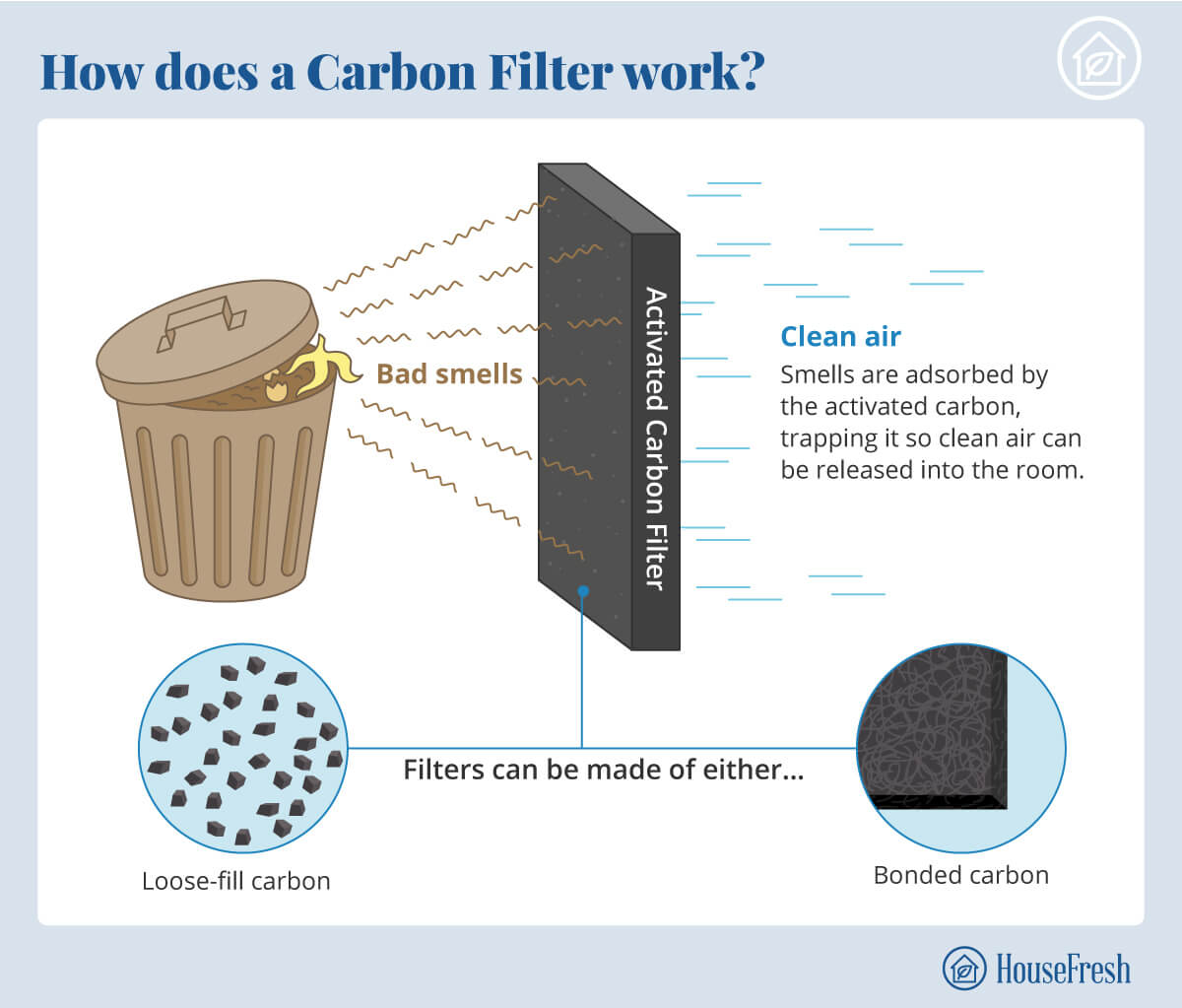
This means that the more carbon a filter possesses, the larger the surface area to lock in VOCs. Filters using carbon pellets are more effective than pleated carbon filters, so keep an eye out for what’s inside and the weight of each carbon filter. Many cheaper air purifiers will use very small amounts of carbon that will be ineffective in dealing with serious odors like weed smoke.
3. Measure the space in which you smoke (and consider how much weed smoke your home is exposed to)
Air purifiers are designed to work at their best in different-sized spaces. Bigger units can usually clean the air in a much larger room than a smaller, budget unit. Manufacturers will often provide a recommended room size for each air purifier, which is a great starting point for consumers.
But be wary of
Once you have measured the space where you want to use your air purifier, you can use our calculator below to find out which CADR rating you will need for your specific space, telling you how much air (measured in cubic feet) a purifier can clean in a minute (CFM).
Remember that weed smoke is thick and full of pollutants, so you’ll need a more powerful unit than if you were to tackle everyday pollutants like dust or cooking smells. Likewise, if you smoke every day, consider purchasing a larger, more powerful unit.
If you are struggling with weed smoke and smells coming through your doors and windows, you will be happy to learn that you won’t need an incredibly high CADR unit to help, but it also depends on how much weed is being smoked.
4. Does the unit utilize any smart features?
Modern air purifiers come with many handy Smart features that can make cleaning the air a doddle. From Auto modes to smartphone apps or even Alexa smart speaker compatibility for voice-activated controls, there is plenty to streamline how you control your unit or even trust it to work all by itself.
This can all make life much easier and result in you having to do less after settling in after a smoke. However, these units can also come with a premium price tag, so if your budget is tight, prioritize cleaning capability over fancy features.
5. Do you need an air purifier at all?
Many people have enjoyed smoking a joint or a bong indoors just fine without using an air purifier, so you may be considering if it’s worth the investment.
Whether or not you think it’s necessary will probably depend on three things:
- Will anyone around you be affected by secondhand smoke?
- Do you need to be discrete when smoking weed indoors?
- Are you bothered by the stale smell that smoke leaves behind?
If you’ve answered yes to any of those questions, then you should take action to reduce the impact of smoking indoors. But with new products on the market, such as the Smoke Trap +, you may also wonder if there are cheaper alternatives to an air purifier.
At first glance, the Smoke Trap + looks like an innovative product. It utilizes much of the same mechanical filtration, uses reusable components and costs a fraction of the price of an air purifier.
However, several key concerns may have you thinking twice about overlooking an air purifier.
First is how much smoke it can remove. While an air purifier draws in air from your whole room, smoke traps only work on the air you exhale – leaving smoke and odor to emit from the source.
With such a small filter, you’ll also find that the trap will struggle to capture all pollutants in a single pass. An air purifier, on the other hand, achieves multiple air changes an hour, circulating dirty air through the filters even after you’ve finished smoking.
The last concern is longevity. With a lifespan of 500 puffs, traps aren’t a great option for those who smoke every day. You’ll soon see the money you saved on the initial purchase go down the drain with frequent filter changes compared to a filter in an air purifier, which can last as long as 5 years.
Common questions about weed smoke and air purifiers
Weed smoke can be divided into two pollutant types: particulate matter (PM) and volatile organic compounds (VOC).
You must utilize two types of filters to remove both from your environment. A primary or HEPA-certified mechanical filter will take care of the smallest particulates suspended in the air. An activated carbon filter will capture gaseous pollutants such as chemical fumes and odors.
An ionizer may help the purifier remove PM particles faster, but they do pose a risk of emitting ozone into your space.
If you smoke weed indoors, you should dedicate a single space to smoke in with plenty of ventilation. This means close to an open door or window and ideally not a thoroughfare to other spaces in the home. Allow residual smoke to escape and utilize an air purifier on its highest speed setting to continue circulating and cleaning the air after closing the windows or door.
If smoke is entering your home from a nearby neighbor, try to close doors and windows in the most affected area (i.e., facing their home). Utilize air purifiers in this space to capture smoke as soon as it enters to prevent it from spreading throughout your own home. Opting for a unit with an Auto mode or low energy draw is useful in this scenario, as you can leave them to clean the air 24/7.
When it comes to removing odor, you want an air purifier with a huge activated carbon filter. Currently, the biggest carbon filter on the market is found in the Austin Air Healthmate. This option contains a staggering 15 lbs. of carbon to lock in odor.
If you’re growing a weed crop, you will benefit from an air purifier that quickly circulates huge amounts of air and contains high-quality carbon filters to reduce the spread of VOCs such as terpenes.
You may want to look into a dedicated device that uses large amounts of carbon, and that is designed for use in grow tents.
What gives weed its iconic odor is an array of VOCs known as terpenes. When you grow, store or smoke the plant, the terpenes are released into the surrounding atmosphere, creating a smell.
If you pass the VOC-rich air through a carbon filter, the terpene molecules will become adsorbed by the porous surface of the carbon (usually charcoal) inside. These odors are then locked inside, leaving clean air to be redistributed.
When smoking indoors, you should increase ventilation as much as possible.
This means opening doors and windows to allow fresh air to flood in and smoke to escape. Utilizing your HVAC or air purifier on its highest speed setting will help circulate air with greater speed.
Without an air purifier, you must rely solely on natural ventilation. Opening your windows and doors can work wonders at airing out smoke. But be warned, it won’t help to remove the odor that is ingrained into furnishings and upholstery, nor capture harmful toxins that linger inside the space for hours, weeks and months at a time.
If you are affected by a neighbor or previous occupier of your home, check out the full guide on removing weed odor, with lots of natural and handy tips.
Most people believe weed smoke is less harmful than cigarette smoke. Yet new studies show this may not be the case:
One recent study found that smoking a joint indoors creates 3.5x more emissions than a Marlboro cigarette.
Scientists have discovered there are 2575 different compounds found in marijuana smoke, including ammonia, mercury, hydrogen, lead and cyanide – all of which are more prevalent in weed smoke than tobacco smoke.
Exposure to these toxins can contribute to a raft of health issues, such as:
- Respiratory conditions including COPD, lung infection and asthma
- Cardiovascular conditions, with increased risk of a heart attack or stroke
- Increased risk of cancer
- Irritation of the nose, throat and eyes
Although smoking a joint creates the most emissions, using a bong or vape still creates high volumes of particulates.
Even once the initial smoke has cleared, dangers from thirdhand smoke still pose a threat. As pollutants are released back into your environment from smoke deposits on walls, furniture and upholstery over time.
Wrapping up
Whether you are a full-blown blunt lover or just partake in the occasional bong hit with friends, having an air purifier to help you rid the air in your home of lingering odors and harmful toxins will be a worthwhile investment.
But knowing which air purifier is the best option for you will vary from person to person.
Overall, you should ensure that whatever air purifier you choose utilizes high-quality primary and carbon filtration to achieve the best level of protection. On top of this, you can look into Smart features, operating volumes and power consumption — all of which are easy to find in our handy Specs charts to find the best unit for your needs.








